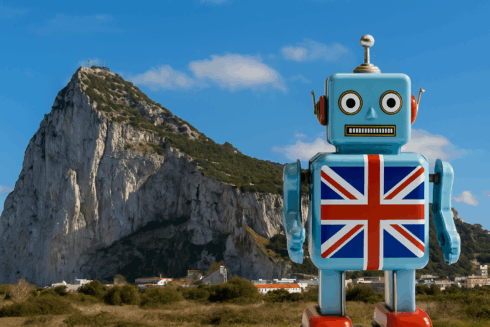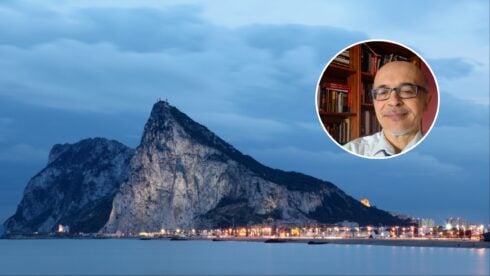GLIDING down the high street of Gibraltar it was impossible to miss Miss World.
But, incredibly, newly-crowned beauty Kaiane Aldorino, 23, went almost entirely unnoticed, without a snapper, autograph hunter or fan in sight, as she window-shopped and enjoyed a rare glimpse of Spring weather last week.
How different it was to her triumphant return in December, when 15,000 people turned out to cheer her crowning in South Africa.
“It is great to be back on the Rock,” she told me, stopping for a chat outside Marks & Spencer. “After recent trips to Japan and Brunei there is something incredibly calming about the place.
“It is partly the unique location, but it is also the incredibly friendly people.”
Aldorino, who scooped the crown in December, is set to become the first genuine Gibraltarian megastar, running fashion designer John Galliano into a clear second place.
Yet, Gibraltar has seen a long line of celebrities over the last few decades, the vast majority however, coming to tie the knot.
“Gibraltar is a completely revamped product”
Cheaper and quicker to marry in Gib than inthe UK. Luminaries of note include actors Sir John Mills, Sean Connery and even John Lennon and Yoko Ono.
The most recent was Status Quo star Rick Parfitt, who married fitness instructor Lyndsay Whitburn, before settling on the Costa del Sol, near Alhaurin.
Wedding snaps taken against the looming backdrop of the Rock – the 426-metre sheer limestone escarpment – must look spectacular. Not that Parfitt hung around long enough to visit the fascinating colony, that includes the only wild monkeys in Europe.
Parfitt and his new wife had departed the postage-stamp size state – which is just two-and-a-half miles square – within an hour of the nuptials.
A few years ago that might have been justified. The first time I visited the British protectorate in the early 1990s, the Rock was little more than a tacky, rubbish-strewn enclave, full of squaddies and Union jack sticks of rock. Its best known restaurant was a Wimpy.
Known for the endless queues to get past the Spanish border guards – the frontier was shut until the early Eighties when reaching the Rock meant a long boat trip via Morocco – most visitors did little more than buy duty-free fags and sink a couple of pints of warm bitter. They might as well have been in Benalmadena.
But things have changed. Not only can you cross the border in under five minutes (having parked you car nearby in La Linea – for under five euros for the day), but the squaddies, who are now outnumbered by the monkeys, have been replaced by new tourist enterprises and a spruced up image.
This means fashionable, waterside restaurants, a slick new marina at Ocean Village, trendy hotels and even Jazz evenings.
There are new cinemas, a new hospital, a brand new casino, as well as all the high street shops (M&S, BHS, Oasis, etc) you would expect in a lively British town.
Largely due to a rapprochement between Spain and the UK, there is plenty of new development going on and even talk of sharing Gibraltar airport, a huge step considering that until recently no Spanish plane could land here.
Flights now go to Madrid and Barcelona and there is even a new ferry taking regular trips to Algeciras.
“Gibraltar is a completely revamped product,” says Dustin Orfila, of InvestGibraltar, a government body encouraging investment. “A decade ago it was scruffy and dirty, today it is cleaner and brighter and appealing much more to upmarket tourism.”
The changes are seeing an increase of 1.5million tourists a year and the enclave has hardly felt the world recession at all. “Only the construction side has suffered,” continues Orfila.
So what is on offer in Gibraltar? As well as beaches, splendid views and a fascinating history. It bristles with the remnants of the British Empire, with countless barrages and gun emplacements at every turn.
Battlements adorn the walls of the old town and in the evocative Trafalgar cemetery you can find the graves of those who died in the famous battle.
Nearby, on Rosia Road, is a monstrous 100-ton Victorian gun marking the spot where Nelson’s body was brought ashore – his corpse had been preserved in a barrel of brandy that was later drunk by sailors for good luck. The naval hero had often visited the Rock while HMS Victory was repaired.
Strolling around, it is easy to appreciate how Gibraltar must have been on an almost permanent war-footing after seizing it from the Spanish in 1704. A series of bitter sieges ended in the construction of shelters and further gun emplacements inside the rock.
Excavations didn’t stop for over 200 years until, during World War II, there were an amazing 32 miles of tunnels inside the rock (many more than on the outside), and space to house 16,000 people.
It bristles with the remnants of the British Empire, with countless barrages and gun emplacements at every turn.
Arguably the most impressive defensive system in the world – like a veritable Swiss cheese – you can now visit the often claustrophobic tunnel network.
Children will love exploring the passages that once held the office of General Eisenhower and thousands of troops, who often did not see daylight for months at a time.
The strategic reasons for such sacrifice are fully appreciated once you climb – or take the cable car – to the top.
Look inland to the pointed peaks of the beautiful Serrania de Ronda; and out to sea, across the Straits to the Rif Mountains of Morocco.
At 1,398 feet you are at the top of one of the mythical pillars of Hercules – the other Jbel Musa just across the sea in Africa.
Peering down at one of the busiest bottlenecks of water in the world (about 12 miles in width) it is easy to understand why Gibraltar has been a key naval base for centuries.
Whoever controlled the Rock, controlled the Mediterranean, a fact not lost on the Phoenicians, who were the first civilisation to build a fortified base.
Following the demise of the Roman empire, the Rock eventually became a bridgehead for a Moorish assault, when in 711 the governor of Tangier Tariq ibn Ziryab led his troops to vanquish the disorganised rabble of Visigoths.
The Arabs went on to rule the area for seven centuries. The Rock was christened “Jbel Tariq”, Gibraltar being an Anglicisation of it, rather like ‘sherry’ and ‘Jerez’.
Nature lovers will enjoy the reserve that protects the top half of the rock. As well as boasting over 600 species of plants, it is one of the best places to watch the millions of birds that migrate between Europe and Africa every year.
But the main draw is of a hairy kind. For it is up here that you will find the only wild apes in Europe.
Numbering some 250 or so, it is unsure exactly how the colony of tail-less Barbary macaques got here from North Africa.
While some say the Moors imported them, it is just as likely that they arrived when the continents were still joined. It was then that the Atlantic rose to breach the isthmus that linked them.
Either way, the monkeys – who divide into half a dozen troops – are a thoroughly entertaining bunch.
Swinging around, interacting with the visitors, grabbing handbags, snatching food, and generally being cheeky, you can spend hours watching them.
Such is their legend that it is said that their departure will herald the end of the English presence here – a superstition that so worried Sir Winston Churchill during WWII that he imported a few dozen more to ensure their survival.
One nearly got the better of me, when he crept up from behind and tried to grab my bag, which was luckily over my shoulder.
Heart pumping, I promptly began the hour or so stroll downhill into town.
The centre of Gibraltar is just as interesting. Closely reflecting the melting pot (Gibraltarians are a curious mix of Italian, Jewish, Maltese, British, Portuguese and German), many buildings have Portuguese tile façades, English wrought iron balconies and Genoese shutters.
Full of remnants of the former colony, one of the best places to take afternoon tea is at the Elliot Hotel in the centre, which has a terrific Jazz night once a week.
As I headed off up the road to San Roque and its famous golf course the following day, I looked back at the imposing landmark with completely different eyes.
Finally I could see what all the fuss was about. Our Rock is truly rocking!
Log on to the PDF of the print edition to see the full ‘All about Gibraltar’ special
Click here to read more News from The Olive Press.






A fine artical for those who have never been to Gibraltar. Be seeing you soon–at the Rock Hotel most likely. JDS
I was just thinking of making a trip to Gibralter, when I came across your post – it was so well done that it kept my attention all the way to the end. Great information!
Haven’t you published 90% of this before? http://theolivepress.es/2007/05/23/gibraltar-rocks/
The beauty of cut-and-paste lol.
Yes correct, some of this article appeared in the olive press three years ago, but the main thrust, indeed the majority is fresh… plus all the rest of the 16 page supplement that was in the last issue was completely new (download our issue 77 online now to see the supplement)
the first Gib megastar?????????…what about Albert Hammond…..